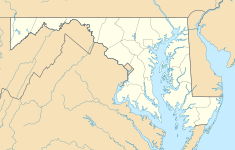Oaklands (Laurel, Maryland)
| Oaklands, Contee | |
|---|---|
| Nearest city | Laurel, Maryland |
| Coordinates | 39°04′33.1″N 76°51′41.2″W / 39.075861°N 76.861444°W |
| Built | 1798 |
| Architectural style(s) | Federal |
Oaklands or Contee was a slave plantation owned by the Snowden family,[1] and remains as a historic home surrounded by residential development.
Description and history[edit]
The house is a three-story Federal architecture manor of brick construction,[2][3][4] and was built by Major Thomas Snowden and his wife Eliza Warfield from Bushy Park, Howard County. The 2,000-acre (810 ha) estate extended westward into modern Howard County. Richard Snowden inherited it from his father. His oldest daughter Anne Lousia Snowden inherited the estate and married Capt. John Contee, for whom "Contee" station of the B&O railroad was named.[5][6]
In 1911, the estate was purchased by Charles R. Hoff and his wife who was a descendant of the Snowden family.[7]
Slavery[edit]
Overseers of this plantation in the mid-1800s were described as particularly cruel to their slaves. Dennis Simms, born in 1841, recalled such in 1937 as part of the Library of Congress Slave Narrative project. "We had to toe the mark or be flogged with a rawhide whip, and almost every day there was from two to ten thrashings given on the plantations to disobedient Negro slaves...We all hated what they called the 'nine ninety-nine', usually a flogging until fell over unconscious or begged for mercy. We stuck pretty close to the cabins after dark, for it we were caught roaming about we would be unmercifully whipped. If a slave was caught beyond the limits of the plantation where he was employed, without the company of a white person or without written permit of his master, any person who apprehended him was permitted to give him 20 lashes across the bare back...We were never allowed to congregate after work, never went to church, and could not read or write for we were kept in ignorance. We were very unhappy...(captured runaways) besides being flogged, would be branded with a hot iron on the cheek with the letter 'R'." Simms said he knew two slaves so branded.[8]
Present[edit]
The Oakland manor is surrounded by residential development. Access to the property is off of 13700 Oaklands Manor Drive.
See also[edit]
References[edit]
- ^ "Oaklands". Maryland Inventory of Historic Properties. Maryland Historical Trust. March 3, 1999. Archived from the original on December 26, 2014. Retrieved 25 December 2014.
- ^ Nathania A. Branch Miles; Monday M. Miles; Ryan J. Quick. Prince George's County and the Civil War: Life on the Border. p. 100.
- ^ Hamill Kenny Museum and Library of Maryland History, Maryland Historical Society (1984). The placenames of Maryland, their origin and meaning. p. 67.
- ^ "Historic Sites and Districts Plan". Issuu. Prince George's County, Maryland. June 2010. pp. 25, 99. Retrieved August 15, 2021.
- ^ Joshua Dorsey Warfield. The founders of Anne Arundel and Howard Counties, Maryland. p. 363. ISBN 0-8063-7971-5. OCLC 14767982.
- ^ Harriet Tubman; Frederick Douglass; Reverend Noah Davis; Josiah Henson; James W. C. Pennington; John Thompson. Tubman, Douglass, and Other Maryland Slave Narratives.
- ^ John Martin Hammond. Colonial mansions of Maryland and Delaware. p. 96.
- ^ Simms, Dennis (September 19, 1937). "Born in Slavery: Slave Narratives from the Federal Writers' Project, 1936 to 1938". Library of Congress. pp. 63–64. Retrieved August 25, 2021.
External links[edit]
- Oaklands, Colonial Mansions of Maryland and Delaware: Prince George's County, Maryland (John Martin Hammond, 1914)
- Photos from Survey HABS MD-109, Oaklands, Contee Road, Contee, Prince George's County, MD (Library of Congress, 1936/1940)

